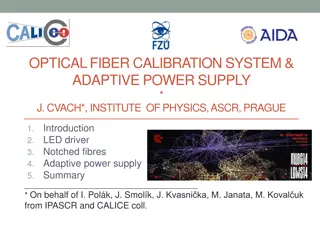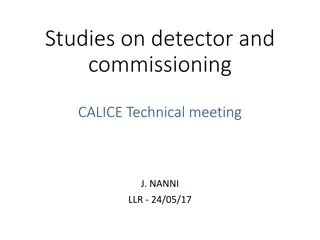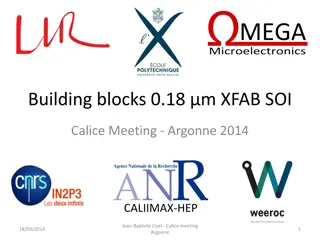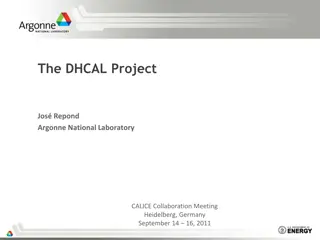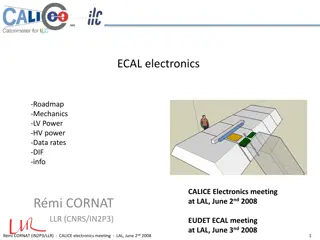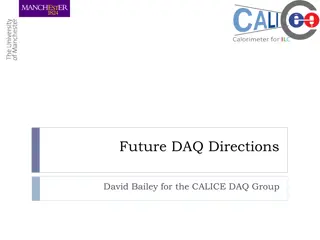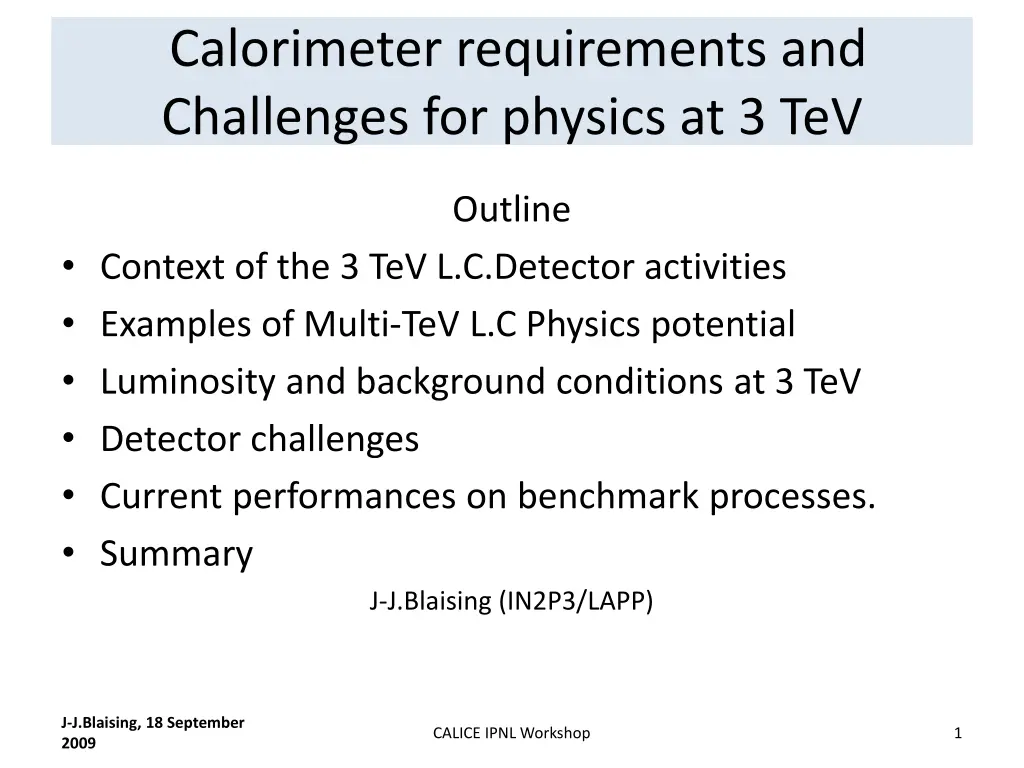
Physics Potential at 3 TeV for L.C Detector Activities
"Explore the potential of sub-TeV and multi-TeV energies in physics research, focusing on Higgs searches, SUSY sparticles, and extra dimensions. Challenges, requirements, and luminosity conditions are discussed."
Download Presentation

Please find below an Image/Link to download the presentation.
The content on the website is provided AS IS for your information and personal use only. It may not be sold, licensed, or shared on other websites without obtaining consent from the author. If you encounter any issues during the download, it is possible that the publisher has removed the file from their server.
You are allowed to download the files provided on this website for personal or commercial use, subject to the condition that they are used lawfully. All files are the property of their respective owners.
The content on the website is provided AS IS for your information and personal use only. It may not be sold, licensed, or shared on other websites without obtaining consent from the author.
E N D
Presentation Transcript
Calorimeter requirements and Challenges for physics at 3 TeV Outline Context of the 3 TeV L.C.Detector activities Examples of Multi-TeV L.C Physics potential Luminosity and background conditions at 3 TeV Detector challenges Current performances on benchmark processes. Summary J-J.Blaising (IN2P3/LAPP) J-J.Blaising, 18 September 2009 CALICE IPNL Workshop 1
Introduction (1) The physics case for a sub-TeV L.C is well established and complementary with LHC goals. The ILC detector concept studies are well advanced; ILD and SiD LoI s were approved recently. LHC will provide us with the scale of new physics. It is generally expected that physics will demand detailed studies at multi-TeV energies J-J.Blaising, 18 September 2009 CALICE IPNL Workshop 2
Introduction (2) CLIC accelerator R&D is progressing well, good synergy with ILC in several technology domains. A Conceptual Design Report (CDR) is planned for end 2010 Collaboration with the ILC detector concepts was initiated by CERN in 2008. Plan to include, in CDR, chapters about CLIC physics potential, detectors concepts and related technological issues . Requests to study the performances of the ILC detectors at multi-TeV energies and CLIC beam conditions. Baseline: machine and detectors should allow covering the 0.5 to 3.0 TeV energy range. J-J.Blaising, 18 September 2009 CALICE IPNL Workshop 3
Physics potential: Higgs searches If the SM Higgs is light, ILC will study many of its properties. At 3 TeV the cross section is significantly larger (Fig 1); it will allow to extend the studies to rare decays; e.g measure H coupling , 4% precision, mh =120 GeV and 0.5 ab-1 (Fig2). If there is new physics ,the Higgs may not be light , going to 3 TeV will be essential. J-J.Blaising, 18 September 2009 CALICE IPNL Workshop 4
Physics potential: SUSY Sparticles (CMSSM) LC 3 TeV LC 1 TeV Fig1: regions of m1/2, m0 plane compatible with HEP and Cosmological data, 0.094 < cdm <0.129 and benchmark points used to compute the Sparticles mass spectra. LSP mass is proportional to m1/2, => Sparticles may be heayv. Fig2 Mass of Next-to-lightest Visible Sparticle vs mass Lightest Visible Sparticle: Full sample , Detectable at LHC, Dark Matter constraint, Direct detectable D.M J-J.Blaising, 18 September 2009 CALICE IPNL Workshop 5
Physics potential: Extra Dimensions Kaluza-Klein excitations of S.M particles appear as resonances in e+ e- annihilations. A multi-TeV L.C would allow to scan a large energy range and study more than one excitation. J-J.Blaising, 18 September 2009 CALICE IPNL Workshop 6
3 TeV Linear Collider Physics at 3 TeV requires high peak luminosity to: compensate s-channel 1/s dependence measure t-channel processes High luminosity requires a very small beam spot size and many bunches. It leads to CLIC parameters with: A specific bunch structure. A strong final focus system. J-J.Blaising, 18 September 2009 CALICE IPNL Workshop 7
CLIC Parameters Expect L ~ 200 to 500 fb-1 /year at 3 TeV J-J.Blaising, 18 September 2009 CALICE IPNL Workshop 8
CLIC train/bunch structure The CLIC train repetition rate is 50 Hz, (ILC, 5 Hz) Train Bunches Number of bunches per train Time interval between bunches 312 2820 308 ns 0.5 ns CLIC: ILC: Trains made of 312 very close bunches, ~16 cm distance. J-J.Blaising, 18 September 2009 CALICE IPNL Workshop 9
CLIC Beamstrahlung Close bunches and strong final focus fields lead to : high-beamstrahlung with large backgrounds Coherent pairs (3.8 108 per B crossing) Incoherent pairs (3.0 105 /Bx) (affect mainly tracking and F/B regions) interactions (3.3 hadron events/Bx ) (affect calorimeters) Muon, neutron background from upstream Distorted CM energy spectrum. Only 1/3 of the luminosity is in the 1% CM energy bin . The train/bunch time structure and the background will generate significant events pile up. J-J.Blaising, 18 September 2009 CALICE IPNL Workshop 10
CLIC Detectors Layout To define the detectors layout, the basic assumption is that experimentation at CLIC will start at 0.5 TeV with detectors based on the ILC concepts. When the energy will be raised to 3 TeV, the detectors will be adapted to cope with the increase in energy, higher background conditions and different events topology, e.g F/B boosted events. Nevertheless some detector components must be planned for 3 TeV from the very beginning, e.g Magnetic system coil and yoke size. HCAL depth and material , to absorb more energetic hadrons. J-J.Blaising, 18 September 2009 CALICE IPNL Workshop 11
CLIC Detectors Layout, 3 TeV To study the high energy, high background related issues as well the impact on the detector performances , ILD and SiD, 3 TeV detector geometry files were created. The main modifications are: Beam pipe with larger radius. Location and size of the vertex detector ( inner radius ~ 30mm); matched to the beam pipe. Forward/Backward regions, LumiCal, BeamCal. W, HCAL (barrel and endcap) with a depth of 7.5 ECAL and HCAL granularity remain unchanged. SiD or ILD simulation/reconstruction software is used for these studies. The calorimeter performances reported today are those of an ILD_3TeV detector type with a 4 T field. J-J.Blaising, 18 September 2009 CALICE IPNL Workshop 12
e + e hadrons At 3 TeV ~ 3.3 e + e hadrons events / Bx ~ 13 particles/Bx <Eh> ~ 1.9 GeV <Pt> ~ 0.9 GeV. J-J.Blaising, 18 September 2009 CALICE IPNL Workshop 13
e + e hadrons Background peaked in F/B region. Fig1: dE/d for 10 ns time window Energy deposit in a 10 cone: ~ 20 Gev in barrel region ~ 200 Gev in F/B regions ~ 7.5 Tev per train in the detector. Time stamping is essential. Fig2: dN/d for 10 ns time window Occupancy/train/cm2 at 2m ~ 0.08 in barrel region ~ 0.3 in F/B regions May be an issue for HCAl if cells >> 1 cm2. J-J.Blaising, 18 September 2009 CALICE IPNL Workshop 14
Detector Challenge e + e + + + W W Without Two jets, close each other, in F/B regions. with 20 Bx hadrons pile up. The backg may spoil the jet energy resolution and affect discrimination variables e.g missing energy, missing E, .. But low E, Pt particles. Reconstructed Y, , Pt values of jets J-J.Blaising, 18 September 2009 CALICE IPNL Workshop 15
Current performances e + e + + + W W 4 Jets L~600 fb-1, m = 1064, m = 554 Gev RMS90/E ~ 9 %, |cos |<0.98 (Intrinsic PFA jet energy resolution for Z decays at rest and |cos |<0.7 is 4.1% for Ejet = 500 GeV.) Mass resolution ~ 13% With background and Pt > 5 GeV RMS90/E increases to ~ 12% J-J.Blaising, 18 September 2009 CALICE IPNL Workshop 16
Current performances e + e H A 4 b L ~ 5 ab-1, m H =1161, mA = 1153 GeV 4b final states with semi-leptonic decays. RMS90 / E ~ 13 % , |cos |<0.98 With background and Pt > 5GeV RMS90/E ~ 16% (Barrel) 22 % (E.C) Mass resolution ~ 15% can be improved with 4C fit. J-J.Blaising, 18 September 2009 CALICE IPNL Workshop 17
Summary New physics expected at the TeV scale. To reach adequate luminosity at 3 TeV, requires a bunch structure and beam conditions which create new and challenging detector issues. With a detector layout adapted to 3 TeV and the current PandoraPFA algorithm (not optimized for high energy), a jet energy resolution RMS90/E of ~9% is obtained for |cos | < 0.98 and Jet energies up to 600 GeV, it increases to ~ 12 % with background pile up. Additional work needed to: Understand the components of the jet energy resolution (calorimeter resolution, track reconstruction efficiency, confusion, leakage) and define the time stamping accuracy necessary to improve the performances. Assess performances on other benchmark processes. J-J.Blaising, 18 September 2009 CALICE IPNL Workshop 18
Thanks Thank ILD and SiD collaborations for the their support: Accessing and setting up of their simulation and reconstruction tools. Software modifications necessary to use the tools for 3 TeV events. Stimulating discussions. We hope that this good collaboration will continue. J-J.Blaising, 18 September 2009 CALICE IPNL Workshop 19

